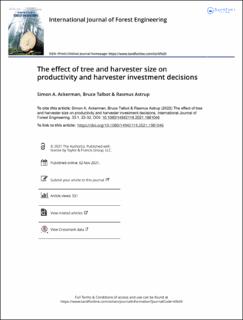| dc.contributor.author | Ackerman, Simon A. | |
| dc.contributor.author | Talbot, Bruce | |
| dc.contributor.author | Astrup, Rasmus Andreas | |
| dc.date.accessioned | 2022-03-04T10:53:33Z | |
| dc.date.available | 2022-03-04T10:53:33Z | |
| dc.date.created | 2022-02-10T21:55:07Z | |
| dc.date.issued | 2021-11-02 | |
| dc.identifier.citation | International Journal of Forest Engineering. 2021, 33 (1), 22-32. | en_US |
| dc.identifier.issn | 1494-2119 | |
| dc.identifier.uri | https://hdl.handle.net/11250/2983099 | |
| dc.description.abstract | Long-term machine-derived data sets comprising 140,000 trees were collected from four harvesters of equal age and similar working conditions, into two machine size classes, viz. two Ponsse Bears and two smaller Ponsse Beavers. Productivity functions for each size class were modelled using a nonlinear mixed effects approach. Based on these functions, unit costs and their sensitivity to utilization rates and cost of capital were assessed. Results showed that despite considerably higher capital costs (32%) on the Bear, a 50% higher mean productivity resulted in a unit cost only 17% higher than the Beaver in a disadvantageous scenario (high interest rates and low utilisation), and a 6% lower unit cost than the Beaver in an advantageous scenario (low interest and high utilisation), within the range of tree sizes observed. Between these extremes, only marginal differences in unit costs were observed. This demonstrates that the difference in ownership and operating costs between larger and smaller harvesters is largely negated by the difference in productivity rates. These results can provide useful insight into timber harvester investment decisions. Harvesters from two adjacent size classes can be used interchangeably at the same unit cost within a wide range of tree sizes despite productivity differences. It should be noted that increased repair costs and an eventual reduction in expected economic lifetime on a smaller harvester, or the negative effects of using a larger harvester in smaller trees, e.g. thinning operations, were not taken into account in this work. | en_US |
| dc.language.iso | eng | en_US |
| dc.publisher | Taylor & Francis Group LLC | en_US |
| dc.rights | Attribution-NonCommercial-NoDerivatives 4.0 Internasjonal | * |
| dc.rights.uri | http://creativecommons.org/licenses/by-nc-nd/4.0/deed.no | * |
| dc.title | The effect of tree and harvester size on productivity and harvester investment decisions | en_US |
| dc.type | Peer reviewed | en_US |
| dc.type | Journal article | en_US |
| dc.description.version | publishedVersion | en_US |
| dc.rights.holder | © 2021 The Author(s) | en_US |
| dc.source.pagenumber | 22-32 | en_US |
| dc.source.volume | 33 | en_US |
| dc.source.journal | International Journal of Forest Engineering | en_US |
| dc.source.issue | 1 | en_US |
| dc.identifier.doi | 10.1080/14942119.2021.1981046 | |
| dc.identifier.cristin | 2000254 | |
| dc.relation.project | EC/H2020/720757 | en_US |
| cristin.ispublished | true | |
| cristin.fulltext | original | |
| cristin.qualitycode | 1 | |

